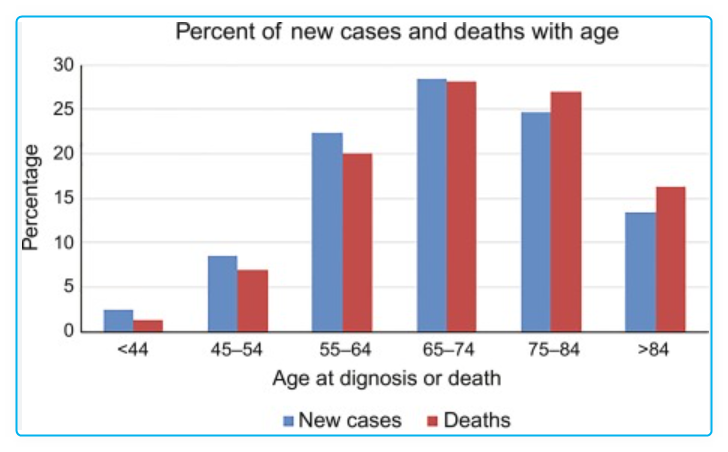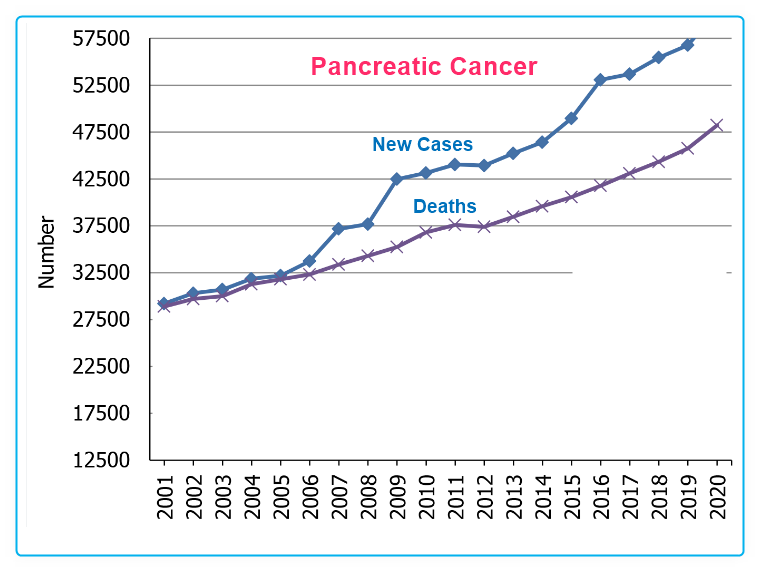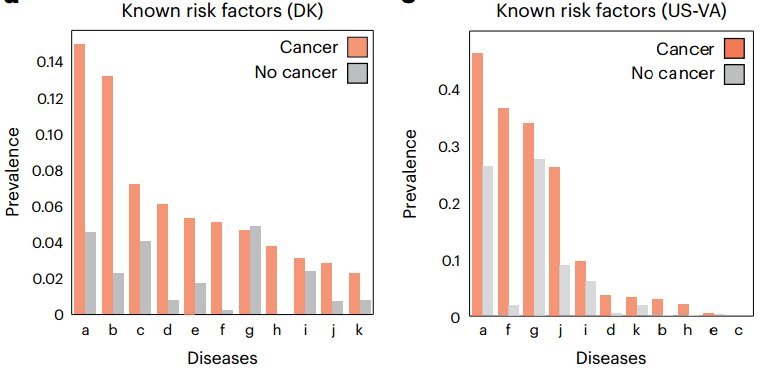Cancer - Pancreatic
Overview Pancreatic Cancer
items in Cancer-Pancreatic
Risk of Pancreatic Cancer significantly reduced by each of:
Vitamin D, Vitamin K, Magnesium, Vitamin D Receptor Activators, and Omega-3
Perhaps the combination would reduce PC risk by >90%
if taken for at least 2, and perhaps 5 years
Pancreatic cancer 55 percent less likely if optimal vitamin D (vs low) – Nov 2017
Pancreatic Cancer survival 2.3 X more likely if good level of Vitamin D – meta-analysis Sept 2023
Pancreatic Cancer is increasing – Vitamin D and Omega-3 should reduce the risk
Pancreatic Cancer – live a year longer if have high vitamin D and good Vitamin D Receptor – Aug 2018
People consuming more Vitamin K1 were 40 percent less likely to get Pancreatic Cancer – Oct 2021
Pancreatic Cancer risk increased 24 percent for every 100 mg less of Magnesium intake – Dec 2015
Pancreatic Cancer charts


The average years of life lost (YLL) due to pancreatic cancer is 15.2 years
Vitamin D Life – Cancer category contains:
{include}
Cancer Treatment with Vitamin D
Children's Cancer hospital now testing vitamin D frequently and supplementing weekly – July 2021
Following breast cancer 100K IU Vitamin D doses twice a month helped a lot – RCT July 2016
Vitamin D is synergistic with many Cancer therapies (radiation in this case) – Aug 2021
Cancer patients in ICU with low vitamin D were 3.4 X more likely to die within a year – Dec 2020
18+ Omega-3 pages with CANCER in title
This list is automatically updated
{LIST()}
12+ Magnesium pages have CANCER in title
This list is automatically updated
{LIST()}
Vitamin D Receptor and Cancer (81+ studies)
Needing a high level of vitamin D is a good clue that the Vitamin D Receptor is deactivated
A poor Vitamin D Receptor is associated with many cancers (oral cancer in this case) – Jan 2019
Vitamin D Receptor pages have CANCER in the title
This list is automatically updated
{LIST()}
Vitamin K and Cancer (8+ studies)
Vitamin K2 appears to treat some cancers – April 2018
Vitamin K pages with CANCER in title
This list is automatically updated
{LIST()}
Pancreatic cancer cells appear to have learned to steal electrons from healthy cells - Feb 2022
Steal to survive: pancreatic cancer’s secret to tumor growth
Note: Many of the nutrients on this page that fight Pancreatic Cancer stop this stealing
studies in Pancreatic Cancer category
{category}
Predict Pancreatic Cancer 3 years before diagnosis - May 2023
Deep learning from 9 million patients records, 30,000 of whom got Pancreatic Cancer
Very different associations found in Denmark vs US

a) Type 2 diabetes mellitus See also Vitamin D Life
b) Unspecified jaundice (good risk factor in DK) see also: Jaundice and vitamin D
c) Hypercholesterolemia
d) Acute pancreatitis
e) Type 1 diabetes mellitus (good risk factor in US) See also Vitamin D Life
f) Other diseases of the pancreas
g) Obesity
h) Malignant neoplasm in other and unspecified parts of bile ducts
i) Inflammatory bowel disease See also Vitamin D Life
j) Weight loss and other food intake problems
k) Malignant neoplasm of colon See also Vitamin D Life
A deep learning algorithm to predict risk of pancreatic cancer from disease trajectories
Nature Medicine (2023) https://doi.org/10.1038/s41591-023-02332-5
Pancreatic cancer is an aggressive disease that typically presents late with poor outcomes, indicating a pronounced need for early detection. In this study, we applied artificial intelligence methods to clinical data from 6 million patients (24,000 pancreatic cancer cases) in Denmark (Danish National Patient Registry (DNPR)) and from 3 million patients (3,900 cases) in the United States (US Veterans Affairs (US-VA)). We trained machine learning models on the sequence of disease codes in clinical histories and tested prediction of cancer occurrence within incremental time windows (CancerRiskNet). For cancer occurrence within 36 months, the performance of the best DNPR model has area under the receiver operating characteristic (AUROC) curve = 0.88 and decreases to AUROC (3m) = 0.83 when disease events within 3 months before cancer diagnosis are excluded from training, with an estimated relative risk of 59 for 1,000 highest-risk patients older than age 50 years. Cross-application of the Danish model to US-VA data had lower performance (AUROC = 0.71), and retraining was needed to improve performance (AUROC = 0.78, AUROC (3m) = 0.76). These results improve the ability to design realistic surveillance programs for patients at elevated risk, potentially benefiting lifespan and quality of life by early detection of this aggressive cancer.
📄 Download the PDF from Vitamin D Life
Suspect in future to be able to identify those needing supplementation to prevent PC

See also: Pancreatitis and Vitamin D - many studies
which includes:
Fat-Soluble Vitamin Deficiencies and Disruption of the Immune System in Pancreatic Cancer- A Vicious Cycle - Sept 2022
